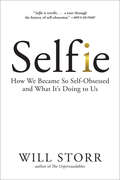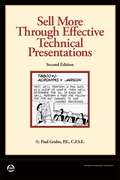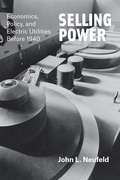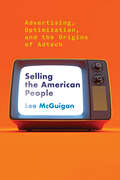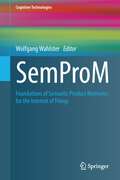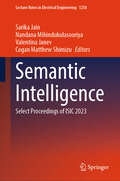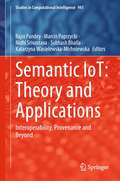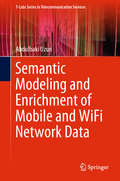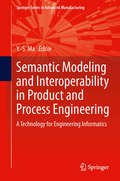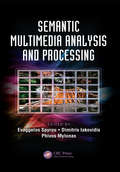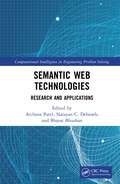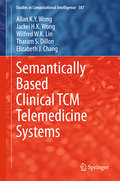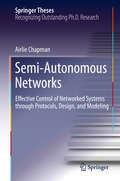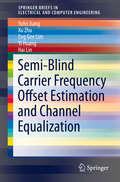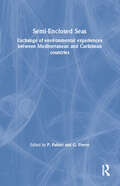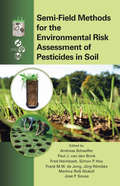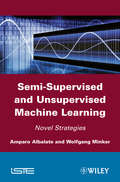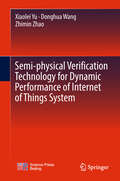- Table View
- List View
Selfie: How We Became So Self-Obsessed and What It's Doing to Us
by Will Storr“An intriguing odyssey” though the history of the self and the rise of narcissism (The New York Times).Self-absorption, perfectionism, personal branding—it wasn’t always like this, but it’s always been a part of us. Why is the urge to look at ourselves so powerful? Is there any way to break its spell—especially since it doesn’t necessarily make us better or happier people? Full of unexpected connections among history, psychology, economics, neuroscience, and more, Selfie is a “terrific” book that makes sense of who we have become (NPR’s On Point). Award-winning journalist Will Storr takes us from ancient Greece, through the Christian Middle Ages, to the self-esteem evangelists of 1980s California, the rise of the “selfie generation,” and the era of hyper-individualism in which we live now, telling the epic tale of the person we all know so intimately—because it’s us.“It’s easy to look at Instagram and selfie-sticks and shake our heads at millennial narcissism. But Will Storr takes a longer view. He ignores the easy targets and instead tells the amazing 2,500-year story of how we’ve come to think about our selves. A top-notch journalist, historian, essayist, and sleuth, Storr has written an essential book for understanding, and coping with, the 21st century.” —Nathan Hill, New York Times-bestselling author of The Nix“This fascinating psychological and social history . . . reveals how biology and culture conspire to keep us striving for perfection, and the devastating toll that can take.”—The Washington Post “Ably synthesizes centuries of attitudes and beliefs about selfhood, from Aristotle, John Calvin, and Freud to Sartre, Ayn Rand, and Steve Jobs.” —USA Today“Eminently suitable for readers of both Yuval Noah Harari and Daniel Kahneman, Selfie also has shades of Jon Ronson in its subversive humor and investigative spirit.” —Bookseller“Storr is an electrifying analyst of Internet culture.” —Financial Times“Continually delivers rich insights . . . captivating.” —Kirkus Reviews
Sell More Through Effective Technical Presentations
by Paul GruhnWhether you're an engineer, a technical salesperson, or a marketing guru, giving presentations is a must to get support for your projects or proposals. This second edition of Sell More Through Effective Technical Presentations provides helpful tips and real-life examples on how to give effective technical presentations from a sales perspective. The ability to present well plays a major role in your success. This updated, easy-to-read guide provides new information on presentation materials, styles, and the use of technology, which will help you become a more competent speaker and let you face a crowd with confidence. The author includes his own humorous cartoons at the start of each chapter to help illustrate what you should or shouldn't do when giving a presentation.
Sellafield Stories: Life In Britain's First Nuclear Plant
by Hunter DaviesSellafield Stories is the largest Oral History Project conducted in the UK. It was started by Jenni Lister, of Cumbria Record Office & Local Studies Library, and was funded by the BNFL.Through the personal life stories of 30 people who lived, worked and built the complex SELLAFIELDS STORIES tells the true story of the Sellafields Nuclear Plant that has been at the heart of the Nation's story for the last 60 years. First set up in the aftermath of World War II to develop Britain's nuclear weapons, it was not until 1957 that it was given over to nuclear power, kick starting a revolution in post war energy. Since then it has been the site of protests, controversy and debate. Today it is still the country's biggest single industrial site employing 13,500 people.
Sellafield Stories: Life In Britain's First Nuclear Plant
by Hunter DaviesSellafield Stories is the largest Oral History Project conducted in the UK. It was started by Jenni Lister, of Cumbria Record Office & Local Studies Library, and was funded by the BNFL.Through the personal life stories of 30 people who lived, worked and built the complex SELLAFIELDS STORIES tells the true story of the Sellafields Nuclear Plant that has been at the heart of the Nation's story for the last 60 years. First set up in the aftermath of World War II to develop Britain's nuclear weapons, it was not until 1957 that it was given over to nuclear power, kick starting a revolution in post war energy. Since then it has been the site of protests, controversy and debate. Today it is still the country's biggest single industrial site employing 13,500 people.
Selling Power: Economics, Policy, and Electric Utilities Before 1940
by John L. NeufeldWe remember Thomas Edison as the inventor of the incandescent light bulb, but he deserves credit for something much larger, an even more singular invention that profoundly changed the way the world works: the modern electric utility industry. Edison's light bulb was the first to work within a system where a utility generated electricity and distributed it to customers for lighting. The story of how electric utilities went within one generation from prototype to an indispensable part of most Americans' lives is a story about the relationships between political and technological change. John L. Neufeld offers a comprehensive historical treatment of the economics that shaped electric utilities. Compared with most industries, the organization of the electric utility industry is not--and cannot be--economically efficient. Most industries are kept by law in a state of fair competition, but the capital necessary to start an electric company--generators, transmission and distribution systems, and land and buildings--is so substantial that few companies can enter the market and compete. Therefore, the natural state of the electric utility industry since its inception has been a monopoly subject to government oversight. These characteristics of electric utilities--and electricity's importance--have created over time sharp political controversies, and changing public policies have dramatically changed the industry's structure to an extent matched by few other industries. Neufeld outlines the struggles that shaped the industry's development, and shows how the experience of electric utilities provides insight into the design of economic institutions, including today's new large-scale markets.
Selling Safety: Lessons from a Former Front-Line Supervisor
by Patrick KarolTo be successful, we need to understand the basic principles of selling and leadership, and how those aspects apply to safety. Supervisors have the greatest influence on employee behavior and are often held accountable for safety performance. Selling safety to upper management is different; it’s very different than selling safety to the front-line employee. Selling Safety: Lessons from a Former Front-Line Supervisor explains the three key characteristics of a successful leader; Vision, Knowledge and Heart. Patrick Karol relates these core characteristics to safety leadership and provides actions that can be used today. He explains the lessons learned based on his experiences and the teachings of current leaders inside and outside the safety field. Offers selling techniques to safety leadership Covers three (3) key components of successful leaders and applies them to safety leadership Presents real life scenarios, examples and obstacles Includes a Safety Leadership Self-Assessment and Personal Action Plan worksheet that readers can use to develop their plan
Selling the American People: Advertising, Optimization, and the Origins of Adtech
by Lee McGuiganHow marketers learned to dream of optimization and speak in the idiom of management science well before the widespread use of the Internet.Algorithms, data extraction, digital marketers monetizing "eyeballs": these all seem like such recent features of our lives. And yet, Lee McGuigan tells us in this eye-opening book, digital advertising was well underway before the widespread use of the Internet. Explaining how marketers have brandished the tools of automation and management science to exploit new profit opportunities, Selling the American People traces data-driven surveillance all the way back to the 1950s, when the computerization of the advertising business began to blend science, technology, and calculative cultures in an ideology of optimization. With that ideology came adtech, a major infrastructure of digital capitalism.To help make sense of today's attention merchants and choice architects, McGuigan explores a few key questions: How did technical experts working at the intersection of data processing and management sciences come to command the center of gravity in the advertising and media industries? How did their ambition to remake marketing through mathematical optimization shape and reflect developments in digital technology? In short, where did adtech come from, and how did data-driven marketing come to mediate the daily encounters of people, products, and public spheres? His answers show how the advertising industry's efforts to bend information technologies toward its dream of efficiency and rational management helped to make "surveillance capitalism" one of the defining experiences of public life.
SemProM
by Wolfgang WahlsterThe development of low-cost, compact digital storage, sensors and radio modules allows us to embed digital memories into products to record key events. Such computationally enhanced products can perceive and control their environment, analyze their observations, and communicate with other smart objects and human users. Digital product memories (DPMs) will play a key role in the upcoming fourth industrial revolution based on cyber-physical production systems, resulting in improvements in traceability and quality assurance, more efficient and flexible production, logistics, customization, and recycling, and better information for the consumer. SemProM was a major industrial and academic research project that examined all aspects of the design and implementation of semantic product memories, and this book is a comprehensive assessment of the results achieved. The introductory chapters explain the fundamental ideas and the organization of the related project, while the remaining parts explain how to build, model and process DPMs, multimodal interaction using them, and selected applications. This work is inherently multidisciplinary and the related ideas, technologies, and implementations draw on results in fields such as semantic technologies, machine-to-machine communication, intelligent sensor networks, instrumented environments, embedded systems, smart objects, RFID technology, security, and privacy. The contributing authors are leading scientists and engineers, representing key academic teams and companies. The book explains successful deployment in applications such as manufacturing, green logistics, retail, healthcare, and food distribution, and it will be of value to both researchers and practitioners.
Semantic Intelligence: Select Proceedings of ISIC 2023 (Lecture Notes in Electrical Engineering #1258)
by Valentina Janev Sarika Jain Nandana Mihindukulasooriya Cogan Matthew ShimizuThis book constitutes refereed proceedings of the 3rd International Semantic Intelligence Conference (ISIC 2023). This book covers a wide range of topics, including semantic web engineering, ontology-based data access, multimodal and multilingual access, machine-to-machine communications and interoperability, knowledge extraction and ontology learning from the web, computational paradigms and computational intelligence, distributed and mobile systems, and many others. This book includes novel contributions and the latest developments from researchers across industry and academia. This book serves as a valuable reference resource for academics and researchers across the globe.
Semantic Interoperability Issues, Solutions, Challenges (River Publishers Series In Information Science And Technology Ser.)
by Carlos Fernandez-Llatas Salvatore F. PileggiSemantic technologies are experimenting an increasing popularity in the context of different domains and applications. The understanding of any class of system can be significantly changed under the assumption any system is part of a global ecosystem known as Semantic Web.The Semantic Web would be an evolving extension of current Web model (normally referred as Syntactic Web) that introduces a semantic layer in which semantics, or meaning of information, are formally defined.So, semantics should integrate web-centric standard information infrastructures improving several aspects of interaction among heterogeneous systems. This is because common interoperability models are progressively becoming obsolete if compared with the intrinsic complexity and always more distributed focus that feature modern systems. For example, the basic interoperability model, that assumes the interchange of messages among systems without any interpretation, is simple but effective only in the context of close environments. Also more advanced models, such as the functional interoperability model that integrates basic interoperability model with the ability of intepretating data context under the assumption of a shared schema for data fields accessing, appears not able to provide a full sustainable technologic support for open systems.The Semantic Interoperability model would improve common interoperability models introducing the interpretation of means of data. Semantic interoperability is a concretely applicable interaction model under the assumption of adopting rich data models (commonly called Ontology) composed of concepts within a domain and the relationships among those concepts.In practice, semantic technologies are partially inverting the common view at actor intelligence: intelligence is not implemented (only) by actors but it is implicitly resident in the knowledge model. In other words, schemas contain information and the "code" to interpretate it.
Semantic IoT: Interoperability, Provenance and Beyond (Studies in Computational Intelligence #941)
by Subhash Bhalla Marcin Paprzycki Rajiv Pandey Nidhi Srivastava Katarzyna Wasielewska-MichniewskaThis book is focused on an emerging area, i.e. combination of IoT and semantic technologies, which should enable breaking the silos of local and/or domain-specific IoT deployments. Taking into account the way that IoT ecosystems are realized, several challenges can be identified. Among them of definite importance are (this list is, obviously, not exhaustive): (i) How to provide common representation and/or shared understanding of data that will enable analysis across (systematically growing) ecosystems? (ii) How to build ecosystems based on data flows? (iii) How to track data provenance? (iv) How to ensure/manage trust? (v) How to search for things/data within ecosystems? (vi) How to store data and assure its quality? Semantic technologies are often considered among the possible ways of addressing these (and other, related) questions. More precisely, in academic research and in industrial practice, semantic technologies materialize in the following contexts (this list is, also, not exhaustive, but indicates the breadth of scope of semantic technology usability): (i) representation of artefacts in IoT ecosystems and IoT networks, (ii) providing interoperability between heterogeneous IoT artefacts, (ii) representation of provenance information, enabling provenance tracking, trust establishment, and quality assessment, (iv) semantic search, enabling flexible access to data originating in different places across the ecosystem, (v) flexible storage of heterogeneous data. Finally, Semantic Web, Web of Things, and Linked Open Data are architectural paradigms, with which the aforementioned solutions are to be integrated, to provide production-ready deployments.
Semantic Knowledge Modelling via Open Linked Ontologies: Ontologies in E-Governance (Artificial Intelligence-Enhanced Software and Systems Engineering #4)
by George A. Tsihrintzis Stamatios TheocharisEvolving technological advances in Artificial Intelligence-empowered Software present significant potential to lead e-Government towards more collective efforts, exchange of experiences on best practices both at national and international levels and dissemination of secluded administrative knowledge. In this book, novel semantic web-based and linked open data-based approaches are developed for the modelling and management of the huge volume of administrative data and the procedures followed by public sector bodies and for the production and management of relevant administrative knowledge. The book consists of eight chapters, each of which includes relevant bibliographic references for deeper probing. Appendices complement this work with sections of configuration files of the applications developed and used. Professors, researchers, scientists, engineers and students in artificial intelligence, e-government and other computer science-related disciplines are expected to benefit greatly from it, along with non-specialist readers from other disciplines who are interested in getting versed in the recent developments in e-government.
Semantic Kriging for Spatio-temporal Prediction (Studies in Computational Intelligence #839)
by Shrutilipi Bhattacharjee Soumya Kanti Ghosh Jia ChenThis book identifies the need for modeling auxiliary knowledge of the terrain to enhance the prediction accuracy of meteorological parameters. The spatial and spatio-temporal prediction of these parameters are important for the scientific community, and the semantic kriging (SemK) and its variants facilitate different types of prediction and forecasting, such as spatial and spatio-temporal, a-priori and a-posterior, univariate and multivariate. As such, the book also covers the process of deriving the meteorological parameters from raw satellite remote sensing imagery, and helps understanding different prediction method categories and the relation between spatial interpolation methods and other prediction methods. The book is a valuable resource for researchers working in the area of prediction of meteorological parameters, semantic analysis (ontology-based reasoning) of the terrain, and improving predictions using auxiliary knowledge of the terrain.
Semantic Modeling and Enrichment of Mobile and WiFi Network Data (T-Labs Series in Telecommunication Services)
by Abdulbaki UzunThis book discusses the fusion of mobile and WiFi network data with semantic technologies and diverse context sources for offering semantically enriched context-aware services in the telecommunications domain.It presents the OpenMobileNetwork as a platform for providing estimated and semantically enriched mobile and WiFi network topology data using the principles of Linked Data. This platform is based on the OpenMobileNetwork Ontology consisting of a set of network context ontology facets that describe mobile network cells as well as WiFi access points from a topological perspective and geographically relate their coverage areas to other context sources.The book also introduces Linked Crowdsourced Data and its corresponding Context Data Cloud Ontology, which is a crowdsourced dataset combining static location data with dynamic context information. Linked Crowdsourced Data supports the OpenMobileNetwork by providing the necessary context data richness for more sophisticated semantically enriched context-aware services.Various application scenarios and proof of concept services as well as two separate evaluations are part of the book. As the usability of the provided services closely depends on the quality of the approximated network topologies, it compares the estimated positions for mobile network cells within the OpenMobileNetwork to a small set of real-world cell positions. The results prove that context-aware services based on the OpenMobileNetwork rely on a solid and accurate network topology dataset. The book also evaluates the performance of the exemplary Semantic Tracking as well as Semantic Geocoding services, verifying the applicability and added value of semantically enriched mobile and WiFi network data.
Semantic Modeling and Interoperability in Product and Process Engineering
by Yongsheng MaIn the past decade, feature-based design and manufacturing has gained some momentum in various engineering domains to represent and reuse semantic patterns with effective applicability. However, the actual scope of feature application is still very limited. Semantic Modeling and Interoperability in Product and Process Engineering provides a systematic solution for the challenging engineering informatics field aiming at the enhancement of sustainable knowledge representation, implementation and reuse in an open and yet practically manageable scale. This semantic modeling technology supports uniform, multi-facet and multi-level collaborative system engineering with heterogeneous computer-aided tools, such as CADCAM, CAE, and ERP. This presented unified feature model can be applied to product and process representation, development, implementation and management. Practical case studies and test samples are provided to illustrate applications which can be implemented by the readers in real-world scenarios. By expanding on well-known feature-based design and manufacturing approach, Semantic Modeling and Interoperability in Product and Process Engineering provides a valuable reference for researchers, practitioners and students from both academia and engineering field.
Semantic Multimedia Analysis and Processing (Digital Imaging and Computer Vision #9)
by Evaggelos SpyrouBroad in scope, Semantic Multimedia Analysis and Processing provides a complete reference of techniques, algorithms, and solutions for the design and the implementation of contemporary multimedia systems. Offering a balanced, global look at the latest advances in semantic indexing, retrieval, analysis, and processing of multimedia, the book features the contributions of renowned researchers from around the world. Its contents are based on four fundamental thematic pillars: 1) information and content retrieval, 2) semantic knowledge exploitation paradigms, 3) multimedia personalization, and 4) human-computer affective multimedia interaction. Its 15 chapters cover key topics such as content creation, annotation and modeling for the semantic web, multimedia content understanding, and efficiency and scalability. Fostering a deeper understanding of a popular area of research, the text: Describes state-of-the-art schemes and applications Supplies authoritative guidance on research and deployment issues Presents novel methods and applications in an informative and reproducible way Contains numerous examples, illustrations, and tables summarizing results from quantitative studies Considers ongoing trends and designates future challenges and research perspectives Includes bibliographic links for further exploration Uses both SI and US units Ideal for engineers and scientists specializing in the design of multimedia systems, software applications, and image/video analysis and processing technologies, Semantic Multimedia Analysis and Processing aids researchers, practitioners, and developers in finding innovative solutions to existing problems, opening up new avenues of research in uncharted waters.
Semantic Web Technologies: Research and Applications (Computational Intelligence in Engineering Problem Solving)
by Bharat Bhushan Narayan C. Debnath Archana PatelSemantic web technologies (SWTs) offer the richest machine-interpretable (rather than just machine-processable) and explicit semantics that are being extensively used in various domains and industries. This book provides a roadmap for semantic web technologies (SWTs) and highlights their role in a wide range of domains including cloud computing, Internet of Things, big data, sensor network, and so forth. It also explores the prospects of these technologies including different data interchange formats, query languages, ontologies, Linked Data, and notations. The role of SWTs in ‘epidemic Covid-19’, ‘e-learning platforms and systems’, ‘block chain’, ‘open online courses’, and ‘visual analytics in healthcare’ is described as well. This book: Explores all the critical aspects of semantic web technologies (SWTs) Discusses the impact of SWTs on cloud computing, Internet of Things, big data, and sensor network Offers a comprehensive examination of the emerging research in the areas of SWTs and their related domains Provides a template to develop a wide range of smart and intelligent applications Includes latest applications and examples with real data This book is aimed at researchers and graduate students in computer science, informatics, web technology, cloud computing, and Internet of Things.
Semantically Based Clinical TCM Telemedicine Systems
by Allan K. Y. Wong Jackei H. K. Wong Wilfred W. K. Lin Tharam S. Dillon Elizabeth J. ChangRecent years have seen the development of two significant trends namely: the adoption of some Traditional Chinese Medicine Practices into mainstream Allopathic Western Medicine and the advent of the internet and broad band networks leading to an increased interest in the use of Telemedicine to deliver medical services. In this book, we see the convergence of these two trends leading to a semantically-based TCM Telemedicine system that utilizes an ontology to provide sharable knowledge in the TCM realm to achieve this. The underpinning research required the development of a three-layer architecture and an Ontology of the TCM knowledge. As TCM knowledge like all medical knowledge is not frozen in time it was important to develop an approach that would allow evolution of the Ontology when new evidence became available. In order for the system to be practically grounded it was important to work with an industry partner PuraPharm Group/HerbMiners Informatics Limited. This partnership was initiated through Professor Allan Wong and the Chairman of PuraPharm Group Mr. Abraham Chan. This led to the system being utilized in more than 20 Mobile Clinics in Hong Kong and 300 Hospitals in China. In order for these different deployments of the system to be coherent with the main core Ontology, it was necessary for us to develop an Ontology Driven Software System Generation approach.
Semi-Autonomous Networks
by Airlie ChapmanThis thesis analyzes and explores the design of controlled networked dynamic systems - dubbed semi-autonomous networks. The work approaches the problem of effective control of semi-autonomous networks from three fronts: protocols which are run on individual agents in the network; the network interconnection topology design; and efficient modeling of these often large-scale networks. The author extended the popular consensus protocol to advection and nonlinear consensus. The network redesign algorithms are supported by a game-theoretic and an online learning regret analysis.
Semi-Blind Carrier Frequency Offset Estimation and Channel Equalization
by Yi Huang Yufei Jiang Xu Zhu Eng Gee Lim Hai LinThis SpringerBrief investigates the performance of semi-blind independent component analysis (ICA) based equalization and carrier frequency offset estimation approaches (CFO) for a number of orthogonal frequency division multiplexing (OFDM) based wireless communication systems. It provides a comprehensive overview of the challenges of channel equalization and frequency synchronization for different wireless systems. The authors present the wireless communication channel and system models. Key existing CFO estimation methods are reviewed, along with a number of the training based and non-training based (blind) channel estimation methods. This is followed by a study of ICA and its applications to OFDM-based wireless communication systems. Later chapters provide a detailed description of recent research on semi-blind CFO estimation and ICA based equalization approaches for various wireless communication systems including multiple-input multiple-output (MIMO) OFDM and coordinated multipoint (CoMP) systems. Semi-blind CFO estimation and equalization structures provide a spectrum-efficient and high-performance solution for high speed wireless communications. This book is suitable for postgraduate students, researchers or professionals in the area of wireless communications.
Semi-Enclosed Seas: Exchange of environmental experiences between Mediterranean and Caribbean countries
by Paolo Fabbri Giuliano FierroProceedings of the International Meeting on UNEP's Regional Programmes in Mediterranean and Caribbean Seas, Genoa, Italy, 12-14 February 1992 which concentrated on three issues of particular interest: water quality, coastal zone management, sea-level rise and the risks and consequences of erosion and flooding.
Semi-Field Methods for the Environmental Risk Assessment of Pesticides in Soil
by Jörg Römbke Andreas Schaeffer Martina Roß-Nickoll Fred Heimbach Simon P. Hoy Paul J. van den Brink Frank M.W. de Jong José P. SousaBased on discussions at the 2007 SETAC Europe PERAS Workshop in Coimbra, Semi-Field Methods for the Environmental Risk Assessment of Pesticides in Soil presents a timely summary of state-of-the-art higher-tier terrestrial risk assessment of plant protection products (PPPs). Influential regulators, academics, and industry scientists provide a compre
Semi-Solid Processing of Aluminum Alloys
by Shahrooz Nafisi Reza GhomashchiThis book describes in great detail the semi-solid processing of aluminum alloys. The authors examine the fundamentals of semi-solid metal processing, provide guidelines for research, illustrate the tools that are employed, and explain the measured parameters for semi-solid processing characterization.
Semi-Supervised and Unsupervised Machine Learning: Novel Strategies
by Wolfgang Minker Amparo AlbalateThis book provides a detailed and up-to-date overview on classification and data mining methods. The first part is focused on supervised classification algorithms and their applications, including recent research on the combination of classifiers. The second part deals with unsupervised data mining and knowledge discovery, with special attention to text mining. Discovering the underlying structure on a data set has been a key research topic associated to unsupervised techniques with multiple applications and challenges, from web-content mining to the inference of cancer subtypes in genomic microarray data. Among those, the book focuses on a new application for dialog systems which can be thereby made adaptable and portable to different domains. Clustering evaluation metrics and new approaches, such as the ensembles of clustering algorithms, are also described.
Semi-physical Verification Technology for Dynamic Performance of Internet of Things System
by Xiaolei Yu Donghua Wang Zhimin ZhaoThis book combines semi-physical simulation technology with an Internet of Things (IOT) application system based on novel mathematical methods such as the Fisher matrix, artificial neural networks, thermodynamic analysis, support vector machines, and image processing algorithms. The dynamic testing and semi-physical verification of the theory and application were conducted for typical IOT systems such as RFID systems, Internet of Vehicles systems, and two-dimensional barcode recognition systems. The findings presented are of great scientific significance and have wide application potential for solving bottlenecks in the development of RFID technology and IOT engineering. The book is a valuable resource for postgraduate students in fields such as computer science and technology, control science and engineering, and information science. Moreover, it is a useful reference resource for researchers in IOT and RFID-related industries, logistics practitioners, and system integrators.
